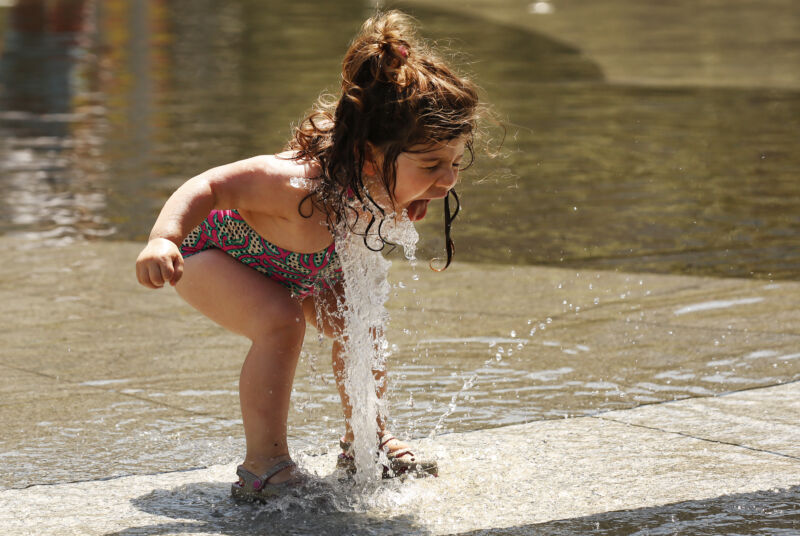Fecal fountains: CDC warns of diarrheal outbreaks linked to poopy splash pads
[ad_1]

In this summer’s record-blazing heat, a spritz of crisp, cool water sounds like delicious bliss. Each drop offering brisk relief as it pitter-patters on your face, quenching your sizzling skin.
But if you find such euphoric respite at a children’s splash pad, that soothing spray could quickly turn to a sickening spew, as the drips and drops may be doused with diarrheal pathogens. Each patter may offer a splat of infectious germs that, if accidentally ingested, could transform you into a veritable fecal fountain in the ensuing days.
That’s the warning from the Centers for Disease Control and Prevention, at least. This week the agency published a report outlining two gastrointestinal outbreaks linked to a single recreational splash pad in Kansas. The two outbreaks, which occurred days apart in June 2021, involved two different pathogens—Shigella bacteria and norovirus—and collectively sickened at least 27 people. Although some circumstances are specific to that particular splash pad in Kansas, the outbreaks highlight the common risk of such facilities, which are often unregulated.
Feculent fun
Splash pads—the popular water venues that can involve interactive fountains, water sprays, and jets—do not typically include areas with standing water. And because of this, “splash pads do not always meet the local, state, territorial, or tribal definition of an ‘aquatic venue'” and may be exempt from public health codes, the CDC notes on its website. “This means they are not always regulated, nor are they always required to disinfect the water with germ-killing chemicals.”
In other words, the water spurting out of those enticing jets could have been filtered through a poopy swim diaper rather than a proper sanitation system. This isn’t just a horrifying hypothetical but a revolting reality. The CDC has tallied a number of such outbreaks over the years and listed the risks for more. The most obvious is that small children generally have poor hygiene and toileting skills and relish sitting and standing on jets, which—as the CDC warns bluntly—”can rinse poop off your butt.” Small children are also most likely to get that water in their mouths, thus completing the fecal-oral route in record time.
The authors of the new report, written by CDC and Kansas health officials, referenced one 2010 study that documented children’s splash-pad behavior and found “children wearing diapers, sitting on water jets, and placing their open mouths to the water.”
Moreover, the jets and sprays themselves pose a risk because when the water gets aerosolized, it depletes the free chlorine concentration, making it more difficult to consistently maintain the concentration needed to prevent disease spread.
Aquatic diversity
If all that wasn’t nauseating enough, the report on the two Kansas outbreaks notes that the splash pad involved was in a wildlife park where people visited exhibits of animals, including lemurs, before going into the water sprays. One of the outbreaks, which occurred on June 11, involved the spread of Shigella bacteria that causes a diarrheal disease called shigellosis.
Nonhuman primates, such as lemurs, are the only known animal reservoir of Shigella. But, the outbreak, which sickened at least 21 children and teens between the ages of 1 to 15, was not linked to touching or feeding the lemurs, outbreak investigators found. Instead, illnesses were associated with playing in the splash pad and getting splash pad water in the mouth. Three sick children had to be hospitalized, and they fortunately recovered.
A week later, on June 18, another outbreak erupted, this time with norovirus. Investigators identified six cases in this outbreak, affecting people between the ages of 1 and 38. All the sickened people played in the splash pad, and all reported getting water in their mouths.
But that wasn’t all. In the days between the two outbreaks, investigators identified more cases of acute gastrointestinal illnesses in people who visited the park, but they lacked laboratory data to link them to either of the identified outbreaks directly. With additional cases identified on June 19, the investigators tallied 63 gastrointestinal illnesses, and the splash pad was closed down on June 19.
Reconsidering regulations
When local health officials investigated the splash pads’ workings, they found some concerning features that could explain the outbreaks, which included that:
Water stood in the collection tank (into which water drains after spraying users and before it is filtered, disinfected, and resprayed) overnight instead of being continuously recirculated, filtered, and chlorinated. The splash pad did not have an automated controller to measure and help maintain the free chlorine concentration needed to prevent pathogen transmission. In addition, no staff member had documentation of having completed standardized operator training.
CDC testing found gastrointestinal bacteria in three of seven pumps used to feed water into splash pad features.
After the splash pad was shut on June 19, the wildlife park addressed the health investigator’s findings, adding continuous circulating, filtering, disinfecting; adding an automated chlorine controller, and training its staff. The splash pad reopened July 24, and no additional splash-pad illnesses were identified.
“As splash pad use increases, exempting splash pads from regulation under public health codes needs to be reconsidered,” the report’s authors concluded.
For now, though, simple messaging can also help prevent splashy outbreaks, such as signs telling splashers and caregivers: “Don’t get in the water if sick with diarrhea,” “Don’t stand or sit above the jets,” and “Don’t swallow the water.”
[ad_2]
Read Nore:Fecal fountains: CDC warns of diarrheal outbreaks linked to poopy splash pads

 Canada
Canada Japan
Japan Germany
Germany Australia
Australia United States
United States United Kingdom
United Kingdom China
China France
France Ukraine
Ukraine Russia
Russia Turkey
Turkey